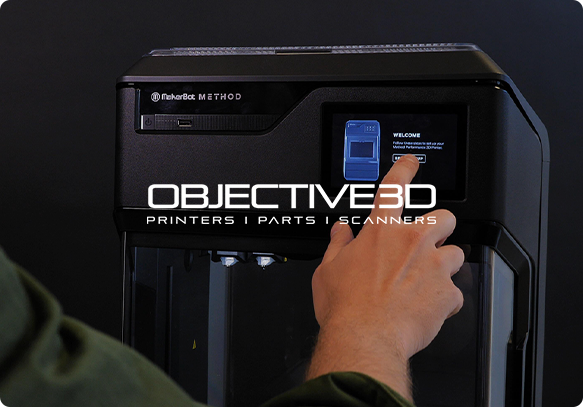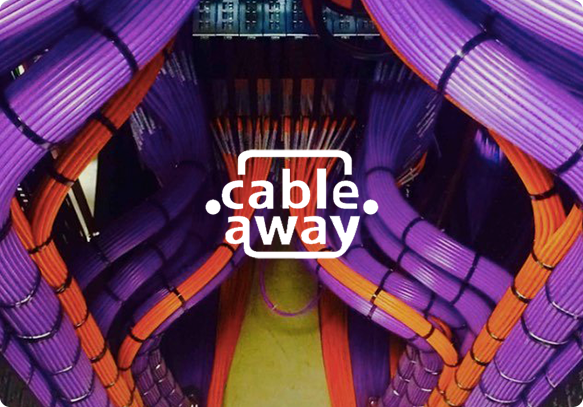3D Printer Company Uses 360 Campaign to Establish Their Digital Footprint
We are showing up everywhere and its great, every time I’m on the web, I see our ads.
Matt Minio – Director at Objective3D
Background
Objective3D is the leading provider of 3D printing and 3D printer solutions to the public in Australia and New Zealand. Our goal working with Objective3D was to help them establish their brand and generate enquiries to pass onto their sales team in order to close these leads into printer sales which would vary anywhere from $30,000 to $1,000,000.
The challenge we faced was that 3D printing technology was relatively new to the Australian market which meant we had to create awareness to generate interest in the product using innovative marketing strategies. We had smaller budgets compared to those of our competitors such as Markforged, 3D Systems and HP.
Objectives
- Launch into the 3D Printing arena and establish a digital footprint
- Educate customers on the output and benefits that each technology provides
- Generate enquiries for 3D Printers from the web and fill their pipeline with highly qualified leads to pass onto their sales team
- Uncover new highly valuable traffic pockets to serve
- Launch a new 3D Printing course to the market to generate awareness and sign ups
Phase 1 – Finding Our Ideal Customers
It was made known to us early by the client that we did not have an endless supply of marketing dollars to break into this market. So, in order for us keep the cost down we needed to know exactly who we were targeting and how best to speak to them.
Through an extensive client discovery exercise completed with the client we were able to break down the market into sub sections with different needs and wants. We later matched those needs with our clients products that matched the sub market goals and objectives. The main drivers were the output requirements, the cost of not using a 3D printer and the savings you could generate from purchasing one or more of these machines. We brainstormed reasons why these “future customers” would need to upgrade to this technology, what technology they may be currently using and the benefits that this new technology could provide.
Being able to identify these audience groups and associate a printing technology or technologies meant we could now produce content that would be so personalised that it had a greater impact when speaking to that desired audience. The effect of this was shown within the campaigns cost per click figures. Our audiences were clicking through our ads at a higher rate, causing our quality score and our ad position to increase. Some campaigns shaved up to $1.50 off what we were previously paying for a click, meaning our budget was being stretched further than ever and we were generating higher quality traffic at a much lower cost.
Educating the Market Through Tailored Social Media Campaigns
After we had narrowed down our market verticals and ideal audiences, we were able to come up with tailored social media campaigns to (A) generate awareness and (B) educate our market. The reasons why we chose social media campaigns over Google campaigns had more to do with being able to serve them highly tailored ads through the endless targeting options made available on these social platforms. Facebook, Instagram & LinkedIn allow you to pick your demographic based on job titles which fitted perfectly with how we wanted to serve our different audience groups with unique and tailored content. The other considered benefits which influenced our decision to use social media campaigns are listed below.
1 The lower cost per click associated in generating more traffic
2 The specific targeting allowed us to focus on unique job roles and marketing segments
3 We could offer customers different marketing materials to enhance the way we engaged with a wider variety of our audience
Our campaigns were built using a series of articles, white paper documentations and videos all tailored to engage people’s interests differently. Using different content pieces meant that we were appealing to a wider audience, stimulating them through different pieces so that they would be encouraged to become more familiar with the technology and more importantly the brand.
As you can see below there are some examples of the different posts and ads we used to incentivise prospects to come across to our site.
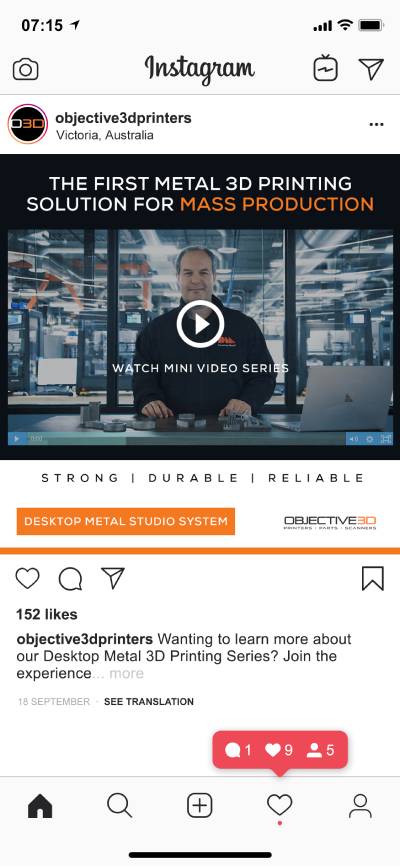
Highly Targeted Video
Metal Printing
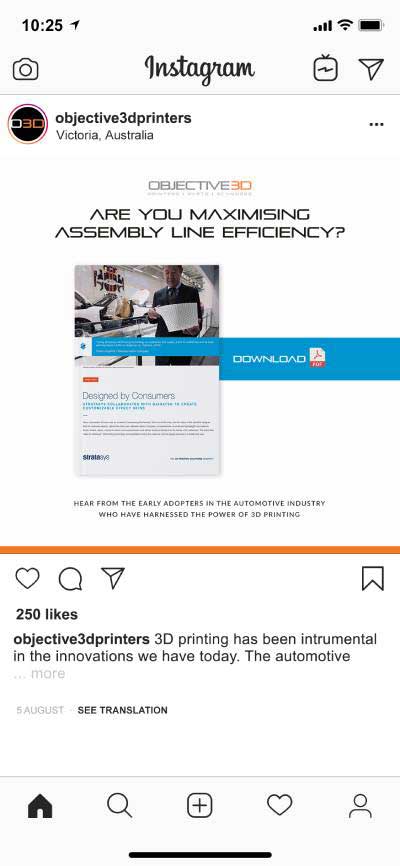
White Paper Document
Assembly Line Efficiency

The best part about offering prospects key information and knowledge about the technology and the industry is that we began to build an authority with our audiences, simply educating them without the intent of selling. With every piece that was consumed a stronger bond was formed between the prospect and the brand. The longer the relationship lasted with the prospect the more reading and viewing would occur. We had an audience that was tuning in, consuming any content that we put out and this was recognised as the pivotal turning point of how our awareness campaign was finally being used to capture the audiences that we wanted.
As this point we were only serving our audience content through a linear method with no follow up campaign.
So we asked ourselves…. how could we keep prospects tuning in longer?
What better way to do this than to have a designated information bank, a place on our site prospects could access anytime and consume as much material they wanted in a single place. So we created a information hub that would be available on Objective3D’s website.
This hub was officially called the “Objective3D Knowledge Centre” . This knowledge centre was given its name because of the way it was designed. We simply didn’t dump all material and content in one place in the hope that our users would take it upon themselves to look through it all.
We categorised all of our past material and gave purpose to it. Each industry was broken down into its own category and then material was nominated on the grounds of how relevant it was to that industry. Each piece of material was then ordered, from entry level to advanced, and would introduce the subject in a greater depth compared to those of our competitors.
To give you an example of what I mean let’s think of this information hub as a ladder. The user would navigate to their preferred category, lets say Aerospace for example. They would then start at the bottom of the ladder where they would be met with the first few pieces of content whether it be a whitepaper, a video introducing the technology and what it’s about. After finishing each piece they would have the opportunity to climb to the next because they were now ready for the next piece of information. Then of course at the top of the ladder there was the highly complex informative pieces waiting for individuals who had consumed all the previous steps and were now ready for more.
This knowledge centre had a monumental shift on the website activity, our bounce rate dropped at an alarming speed, our time on page & time on site tripled but best of all we uncovered a gold mine of data. We were learning more about our prospects behaviour than ever before. We started to gain insights on what future information we should create, what industries we should spend more time on giving us even more direction for our marketing.
*The screenshot below shows the dashboard for the knowledge centre as seen on the Objective3D website.
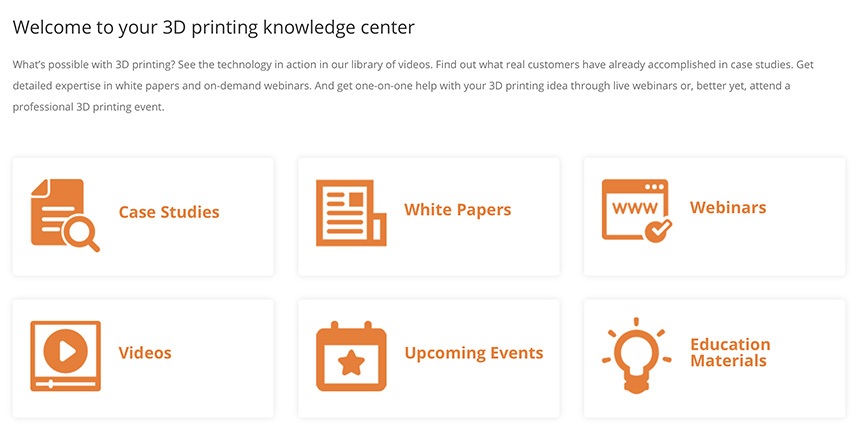
Capturing Leads With The Little Help Of Human Behaviour
The segmentation of our audience groups became easier to identify now that we had categorised our material. At this stage we were still looking for new ways to leverage off the amount of traffic and engagement our resource library was generating.
The only problem now, was that we had an abundance of data, a greater understanding of user behaviour…. but no hot leads.
Capturing the personal information of these people would be the last objective for us to complete before handing these leads over to the sales team so they could start their follow up process.
To give ourselves a better chance at success for capturing a lead, we looked at using the common principles of human behaviour. Lets take the “Get It Right The First Time Video” pictured above.
In most cases marketers use the bait of making the video unplayable until there is an exchange for the customers name and email. This may seem like a great move but in this case it was not as the risk was greater than the reward.
Firstly let’s place ourselves in the prospects shoes. The probability of them submitting their details prior to watching the video is low because at this stage they have not been given anything for the exchange thus making the risk greater than the reward for them. Now lets look at this from Objective3D’s stand point. If we use this method to generate leads our risk is far higher than our reward for two reasons. The first being we could miss out on the opportunity of the lead and we might not get another chance again depending on whether the prospect felt that this method was too intrusive. The second and the far greater risk in our eyes was that after the prospect denies handing their details over, they will simply leave the site without consuming any of the content that was set out for them.
This insight allowed us to rethink the method so that we could lower the risk for our client. What we did instead was, set a number of triggers that would fire once a prospect had watched over 60% of the video. By doing this, we could now measure the interest level of our prospects as they go through and consume our content. The first commitment takes place when the prospect is given the opportunity to consume free content. The second takes place when the prospect reaches over the half way point of the video, he or she is unaware that they have now committed to watching it until the end. This is the exact moment where they are met with the prompt. This type of commitment takes place on a conscious level, and because of their two previous commitments, the ability for them to take this risk doesn’t seem so bad.
The other added benefit of this strategy is that we could filter the “time wasters” and uncover a unique audience group that is both;
1 Worth Their Weight In Gold
2 Closer To The End Of Their Buyers Journey
Phase 2 – Capturing Those Curious Prospects with A Net
Now that we had our information hub generating awareness for a large audience group we had to think about the traffic which were not leaving their details with us. They were obviously interested and worth the effort but what were they doing after they left our site?
If we were to map out the pathway that the prospects were exploring it would look a little something like this.
- Viewed our ad on social media
- Visited our website
- Consumed a piece of educational material
- Left our website
- Few weeks later searched for us
- Noticed our ad on a social media platform
- *Remembered our company or printer name
We needed to have something in place for those who directly searched for us and it was apparent that this was happening (see screenshot below)
Our direct traffic had increased meaning prospects were trying to find us, but we didn’t have a campaign geared to dealing with this influx of new searches.

We used Googles AI dynamic search ads to drive our AdWords campaigns. These types of ads allowed us to target more unique searches per ad. We paired our search results with the most common keywords that a prospect would type in after consuming a specific piece of information. The categories and keywords were broken down and are listed below.
01 Brand Name
02 The technology associated with the printer
03 Ad or article they had read
04 The printer model and make
Our search ads started to funnel these prospects back onto our website where they could re-visit previous pieces they had engaged with, consume new material which they may have missed or be given an opportunity to be prompted to download more specialised information in an exchange for their personal details.
By serving our ads into these high traffic areas where our presence was lacking we started to gain more and more momentum in generating leads. As you can see from the screen shot below we had generated over 1,246 high quality leads from campaigns designed to absorb the overflow of traffic caused by our awareness efforts.

Phase 3 – Finding New Qualified Audiences with The Power of Artificial Intelligence
Now that our foot was firmly on the gas pedal it was time to figure out ways we could use this knowledge to leverage and scale from all the foundations that had previously been put in place. The data gathered by AdWords, Google Analytics & the sales team allowed us to pin-point the average sales cycle of a prospect. We collected data from when the prospect first interacts with our ad, all the way till they purchased, which will often be a 12- 18 months buying cycle.
Educating customers for this length of time is an expensive task so we started to ask ourselves how could we jump the cue to find prospects that were already semi qualified?
We leveraged from the lists that we currently had.
How do you do this?
We uploaded our lists of previous prospects and users that interacted with our resource library and those who submitted enquiries with us via our LinkedIn & Facebook platforms. This allows the AI to review the prospects commonalities so that it could find the link between these people and pinpoint aspects such as similar interests, buying behaviours, followers/pages, comments they have made, blogs they read etc. The reason it can do this is because it tries to formulate an algorithm which is unique to your business so that it has the ability to find new prospects that look the same as those who you have already interacted with. What this meant for Objective3D is they didn’t need to sift through audience groups looking for ideal prospects which is often where the most time and money is lost.
After the algorithm is complete the A.I populates a list to the 1% of your ideal prospect. In order to gain maximum results from our algorithm we broke these lists down into the different areas where prospects were most likely to leave their details.

As you can see from the screenshot below there are a few examples of the machine learning lists we had built for the client to help us find new highly qualified traffic pockets.

By doing this we were able to lower our Cost Per Click and increase our Click Through Rate as we were serving audiences which we knew had some relation to the business, the product or the brand.
This level of A.I integration within our marketing campaign allowed us to create an omni-channel experience so that we could serve our material to new pockets of highly qualified traffic without increasing the cost of our marketing budget. This new awareness being generated helped bring more prospects over to our client website, filling the funnel with better targeted prospects in which we could educate and capture, so that they could be passed onto the sales team.
The Successful Promotion of Objective3D’s New Additive Manufacturing Courses
Objective3D had such great success in becoming the industry leaders within the Australian market that today they are continuing to educate the market with their campaigns in a different light by offering short courses that are available to the public.
How would we look to generate interest in a course that has never been heard of before, which is not available at any university?
Well… That’s exactly what we used in our ad copy.
We wanted to generate exclusivity to users of the technology or those who were wanting to get into the industry by telling them that this was the only place that could offer this great opportunity.

The problem we faced, was that initially prospects might become sceptical in signing up to a course without any social proof that people had attended this course before them.
So we took to using Objective3D’s current database of customers to try and fulfil the first course. There are two reasons that pushed us to do so..they were;
1. Finding new prospects using paid advertising could become an expensive and lengthy task
2. These customers were already familiar with our brand and our technology
We had great success in filling our first few courses, which allowed us to capture priceless video content of happy attendees who completed the workshop.
Hear from our Workshop Attendees
With the injection of social proof, we could now run our campaigns on social media platforms such as Facebook to generate interest and awareness from new prospects.
We used Facebook’s lead generation ad format to be the main driving force of our campaign as we needed to capture leads, fast.
A lead generation ad is quite similar to a display ad with one unique twist. Rather than relying on the prospects good will to go through a landing page and submit their details this ad type prompts them right then and there.
We had the scarcity and hype from the ad, the social proof and now we had an ad format to match. Once an interested prospect had seen the ad and hit the sign up button they were met with the following fields.
- Name
- Phone Number
- Email Address
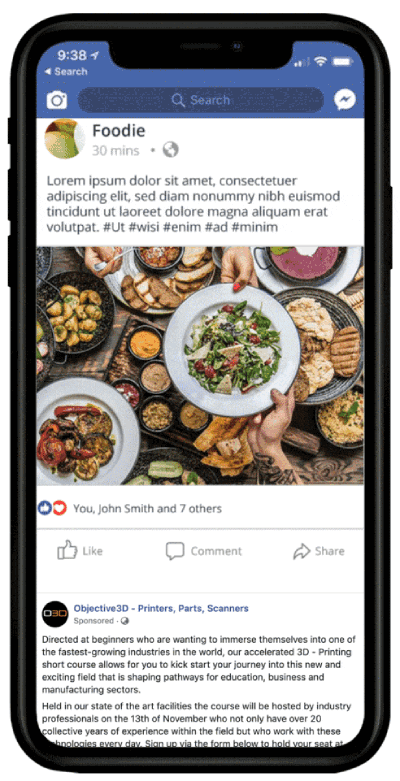
The success of this campaign was achieved with the use of this smart ad format as this campaign secures close to 8 qualified leads per week which cost on average $9 and $16. Little price to pay for a course thats worth $500 to attend and can lead to the sale of a 3D Printer.
With the success of this workshop Objective3D decided to open a second training course, aimed at Auto Cad operators. Given that the objective of that course was quite similar we used the same ad format to help us generate leads.

Conclusion
Their expertise and specialist knowledge in optimising our campaigns has meant we have gotten the results we couldn’t have achieved otherwise – Vernon Tang
FIVE STAR
CUSTOMER RATING
Through implementing these different campaigns and using different marketing platforms we created a 360 approach to how we would serve our audience. Here is a breakdown of our unique 360 campaign for Objective3D.
Scoping:
We used our client discovery exercise to begin with so that we could truly understand who our target audience was. This allowed us to break down our markets and split them into categories so we could determine which we would go after and why.
Content Creation:
From the Client Discovery exercise we were able to build new exciting content geared to engage with new traffic sources on social media platforms. The purpose of these campaigns was to provide educational material to a market that was new and somewhat deprived of information. Through these campaigns we established long term relationships with our audience groups as we proved to be the go to source when it came to providing high quality information.
Resource Library:
The creation of the resource library opened the doors for new opportunity for Objective3D. It allowed them to;
– Continuously educate a new market
– Leverage from the data they were capturing
– Understand their prospects better than any of their competitors
– Capture higher qualified leads
To this day the resource library is being updated with the likes of ‘smart content’ as each piece is carefully created from the analysis of data based upon users engagement with previous information pieces.
This level of predictive marketing gave Objective3D the upper hand as they have the ability to keep their level of engagement high with their audiences.
Capturing The Direct Traffic Generated By The Awareness Campaigns:
With awareness now at an all time high for 3D Printing the implementation of a Google AdWords campaign allowed us to deal with the influx of daily searches that were targeted around the brand, the printing technology or content in which a user had engaged with.
By doing this we bridged the gap between our awareness campaigns and our direct search campaigns creating an omni channel experience for our audience groups. This meant that users could find us on multiple platforms as we had two campaigns working together ensuring we were present whenever they were active online.
Harnessing The Power Of A.I with Facebook & LinkedIn:
Harnessing the machine learning capabilities on both LinkedIn and Facebook, allowed us to leverage from the database that we had grown since running these campaigns. With this level of intelligence we were able to provide the A.I system, which formulated our ‘ideal customer’ which was populated into a list and used to serve our advertising material to. By using machine learning we were able to test new traffic pockets within niche markets with the reassurance of saving on both time and money.
The Launch Of The New 3D Printing Training Course:
With the great success of our educational awareness campaigns, Objective3D was able to offer their customers and prospects a unique course where they’d allow them to visit their showrooms, giving them an opportunity to interact with the technologies in a small group environment.
Being the first in the market to offer a course like this did come with it’s challenges but it also gave us the marketers the ability to offer a level of exclusivity within our advertising . We once again leveraged from the use of our lists, advertising to a pool of people who already knew us, increasing our overall chances of filling the spots.
Social proof was added to our campaign after the successful completion of the first two workshops, as we had the ability to showcase the course through video so that we could add this missing element of social proof to our campaigns.
Recap:
As you can see from above the success of Objectives3D’s marketing campaigns were not boiled down to one technique or sales funnel but instead a combination of strategic planning and smart marketing campaigns.
Bridging our campaigns allowed us to create an omni channel experience giving us the ability to showcase the material over multiple platforms and devices. Users were able to continue their journey in discovering more about Objective3D no matter what platform or device they were on.
If you haven’t already checked out the short video above, please take a minute to hear Vernon Tang, Regional Marketing Manager for Objective3D as he shares his kind words about the execution of these campaigns and the success it has brought to their business.
Goals
- Establish a strong digital footprint and break into the 3D Printing market
- Educate the Australian market about this new technology and its benefits to businesses
- Generate leads for the 3D Printing technology that was being sold to the public
- Establish who our ideal prospect is and find new targeted audiences and market verticals to explore
- Generate leads for new 3D Printing courses offered to the public
- Find new target markets without the use of an excessive budget
Approach
- Complete customer profiling (Client Discovery exercise) and business scoping to identify ideal customer
- Generate tailored and engaging content to be displayed on social media platforms to generate awareness and traffic to the website
- Use Google PPC tool and AI to capture prospects looking for us so they can enquire about the technologies of interest
- Structure our campaigns so that we could optimise the performance of market segments to see what segments were more inclined to engage with the business
- Use Facebook’s AI to find more qualified prospects without using excessive amounts of budgets
- Use Facebook’s smart campaigns to associate lead capture forms directly on our ads to generate leads for Objective 3D’s new courses
Results
- Objective 3D is now seen as one of the largest resellers of 3D Printing technology within Australia
- The Australian market is becoming more adaptive of this new technology and using Objective 3D’s resource library to educate themselves daily
- The Google AdWords campaign that is currently running generates close to 50+ leads per month
- We found new qualified traffic pockets to explore that consist of close to 80,000 people or more who we know are interested in 3D Printing technology
- We have been helping to fill the training courses for the client each month by generating leads for the sales team to follow up directly from facebook




